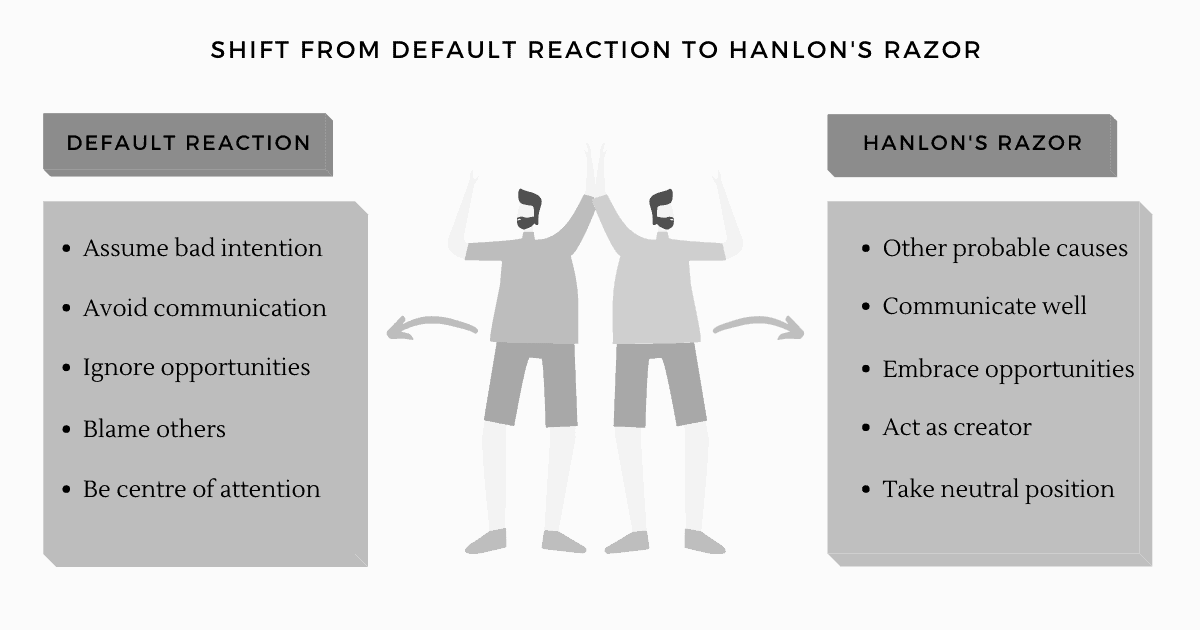Introduction
In our daily lives, we encounter countless situations where we must make decisions. However, our judgment can sometimes be clouded by biases and preconceived notions, leading us astray from rational thinking. Hanlon’s Razor, a powerful mental model, provides us with a valuable tool for understanding the interplay between human psychology and decision-making processes. In this blog post, we will explore the concept of Hanlon’s Razor, its relevance in decision-making, examples of its occurrence, underlying mental biases, strategies to identify and avoid falling prey to it, and the overall implications of this mental trap.
Understanding Hanlon’s Razor
Hanlon’s Razor can be succinctly defined as follows: “Never attribute to malice that which is adequately explained by incompetence or ignorance.” This mental model, often attributed to Robert J. Hanlon, urges us to assume good intentions rather than assuming ill will when trying to understand the actions or behaviors of others. It reminds us that people are more likely to make mistakes, act ignorantly, or lack sufficient competence, rather than purposefully acting with malicious intent.
Relevance in Decision-Making
Hanlon’s Razor is highly relevant in decision-making processes as it helps us avoid unnecessary negativity and promotes empathy and understanding. By adopting this mental model, we can curb our inclination to jump to negative conclusions about others’ motives, allowing for more effective problem-solving and collaboration.
Anchored in Human Psychology
Hanlon’s Razor is deeply anchored in human psychology, primarily due to two prevalent biases: the fundamental attribution error and the negativity bias. The fundamental attribution error refers to our tendency to overemphasize internal characteristics or motives when explaining others’ behavior, while underemphasizing external factors. The negativity bias, on the other hand, highlights our tendency to give more weight to negative information or experiences than positive ones. These biases, combined with our innate inclination to seek patterns and assign intentionality, create fertile ground for the application of Hanlon’s Razor.
Examples of Hanlon’s Razor in Various Contexts
- Personal Life Decisions: Imagine a scenario where you lend money to a friend, fully expecting it to be repaid within a specific timeframe. However, as the deadline approaches, your friend fails to repay the loan. Instead of immediately assuming that they intentionally deceived you, Hanlon’s Razor prompts you to consider the possibility that your friend’s actions were a result of their financial struggles, forgetfulness, or a lack of organization.
- Business Scenarios: In the corporate world, misunderstandings and miscommunications can be frequent occurrences. When a colleague consistently fails to respond to your emails or meet deadlines, it’s easy to jump to the conclusion that they are intentionally avoiding you or neglecting their responsibilities. Applying Hanlon’s Razor, however, encourages you to consider the possibility that their actions are a result of work overload, poor time management, or technological glitches rather than a deliberate effort to undermine your collaboration.
- Public Policy-Making: In the realm of public policy, there are instances where seemingly irrational decisions are made. For example, a government may implement a policy that seems to contradict the best interests of its citizens. Rather than immediately assuming nefarious motives, Hanlon’s Razor invites us to consider the possibility that the decision-makers lacked relevant information, misunderstood the complexity of the issue, or succumbed to groupthink.
Understanding the Psychological Underpinnings
Hanlon’s Razor is intertwined with various psychological biases and fallacies that influence our thinking:
- Confirmation Bias: Our tendency to seek and interpret information that confirms our pre-existing beliefs can lead us to jump to negative conclusions about others’ intentions.
- Availability Heuristic: This bias leads us to give greater weight to information that comes readily to mind. Negative or memorable experiences with others can overshadow the more numerous positive interactions, distorting our perception of their intentions.
- Self-Serving Bias: This bias leads us to attribute our own successes to internal factors, such as competence or effort, while attributing our failures to external factors. This bias can cause us to attribute the failures of others to incompetence rather than considering other factors at play.
Avoiding the Hanlon’s Razor Pitfall
Identifying when we might be succumbing to Hanlon’s Razor is crucial for making objective decisions. Here are strategies to help us avoid this cognitive trap
- Assume Good Intentions: Start by consciously adopting the mindset that incompetence or ignorance is often the reason behind others’ actions. This shift in perspective fosters empathy, collaboration, and open-mindedness.
- Seek Contextual Information: Before jumping to conclusions, gather more information about the situation and the people involved. Communicate openly and clarify any misunderstandings to avoid making hasty judgments.
- Challenge Biases: Be aware of the biases that can influence your thinking, such as the fundamental attribution error, negativity bias, confirmation bias, and self-serving bias. Actively question your assumptions and seek alternative explanations.
Conclusion
Hanlon’s Razor offers us a powerful mental model for navigating the complexities of human interactions and decision-making. By assuming good intentions and recognizing the prevalence of incompetence or ignorance over malice, we can foster more constructive relationships, both personally and professionally. By understanding the psychological biases that contribute to Hanlon’s Razor, we can become more self-aware and better equipped to avoid falling into this cognitive trap. By applying the strategies outlined, we can make more objective decisions, foster empathy, and contribute to a more harmonious society. Let Hanlon’s Razor be our guide as we strive to build bridges and understand the intentions behind human actions.
